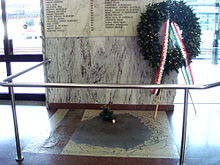Bologna stop
The attack in Bologna ( Strage di Bologna in Italian ) was a bomb attack on the main train station in the Italian city of Bologna on the morning of August 2, 1980. 85 people died and more than 200 were injured. Immediately after the attack, both left-wing and right-wing extremist terrorist groups were accused of perpetration, and the police received various calls to confess them on both sides. After six years of investigation, investigating magistrate Felice Casson was able to prove that the perpetrators must be neo-fascists who had contacts with the Italian military intelligence service. Now the neo-fascist terrorist organization Ordine Nuovo has been accused of having carried out the attack. Two agents of the Italian secret service SISMI and the chairman of Propaganda Due (P2), Licio Gelli , were convicted of obstructing the investigation.
Course of events
A time bomb hidden in a parked suitcase detonated at 10:25 a.m. in a crowded waiting room at the train station. The explosive device consisted of TNT and T4 . The explosion destroyed the western wing of the reception building and damaged a train that was traveling between Ancona and Chiasso and stopped on platform 1. The explosion could be heard for miles. The roof of the waiting room collapsed, greatly increasing the death toll.
On that first Saturday in August, one of the main travel days in Italy, many travelers were in the train station. The city was not prepared for such a major disaster. There were not enough ambulances available, so buses and taxis had to be used to transport the injured to the hospitals.
The Italian government under Prime Minister Francesco Cossiga and the police initially assumed an accident. However, it was soon established that an offshoot of the Ordine Nuovo , the Nuclei Armati Rivoluzionari (NAR), was responsible for the attack. In a special session of the Senate, Cossiga supported the theory that the attack was carried out by neo-fascists. Several attempts were made to obstruct the investigation and to cover up the circumstances of the attack.
enlightenment
The assassination was followed by a long, tangled, and controversial trial and political debate. The survivors of the victims set up an organization (Associazione tra i familiari delle vittime della strage alla stazione di Bologna del 2 agosto 1980) to raise public awareness of the case. On November 23, 1995, the Corte Suprema di Cassazione announced the final verdict:
- The life sentences against the neo-fascists and members of the Nuclei Armati Rivoluzionari (NAR) Valerio Fioravanti and Francesca Mambro , who always protested their innocence, have been confirmed. The court found her guilty of carrying out the attack.
- The chairman of the Propaganda Due , Licio Gelli , Francesco Pazienza and the two SISMI -Beamten Pietro Musumeci and Giuseppe Belmonte were convicted of obstruction of the investigation.
Fioravanti was released in 2009 for good conduct after 26 years in prison, Mambro a year later. They married in prison in 1985. Both always denied responsibility for the attack in Bologna.
In November 2014, a civil court in Bologna sentenced Fioravanti and Mambro to pay the Italian state € 2.13 billion in compensation. The amount was set by the court as compensation for the material and moral damage as well as for the procedural costs. The court thereby recognized the claims that lawyer Fausto Baldi had submitted on behalf of the government.
Fatalities
| nationality | Victim |
|---|---|
|
|
77 |
|
|
3 |
|
|
2 |
|
|
1 |
|
|
1 |
|
|
1 |
|
|
|
Work-up
August 2nd was proclaimed a day of remembrance for the victims. The city council of Bologna and the Associazione tra i famigliari delle vittime della strage alla stazione di Bologna del 2 agosto 1980 organize an annual international composers' competition, which ends with a concert in the main square of the city, Piazza Maggiore .
The damaged parts of the building were rebuilt, but the floor and a deep crack in the wall were kept unchanged as a memorial to the attack. In addition, the station clock stops at 10:25, the exact time of the explosion.
After the arrest of Rodolfo Almirón , a former member of Alianza Anticomunista Argentina , in 2006, Spanish lawyer José Angel Pérez Nievas announced that “it is likely that Almirón - along with Stefano Delle Chiaie and Augusto Canchi - participated in the assassination attempt was involved in the Bologna train station in 1980 ”.
Web links
- 25 years ago: Bomb attack in Bologna train station - Italy and the terror from the right , report by Karl Hoffmann on Deutschlandfunk , August 2, 2005
- stragi.it , official website of the Association of Survivors of Victims (Italian)
- International composers competition "2 Agosto"
- L'ora della verità ( Memento of May 9, 2008 in the Internet Archive ), organization that is convinced of Luigi Ciavardini's innocence and tries to point out errors in the judicial process (Italian)
Individual evidence
- ^ Sven Felix Kellerhoff : Bologna assassination 1980: passengers, squeezed to death . In: THE WORLD . August 2, 2020 ( welt.de [accessed August 5, 2020]).
- ↑ news.orf.at of November 19, 2014
- ^ Strage di Bologna: vittime ( Memento from July 28, 2014 in the Internet Archive )
- ↑ Denuncian que Almirón también participó en la ultraderecha española. Argentine News Agency Télam , January 6, 2007, archived from the original on September 27, 2007 ; Retrieved November 13, 2009 (Spanish).
Coordinates: 44 ° 30 ′ 21 ″ N , 11 ° 20 ′ 33 ″ E



